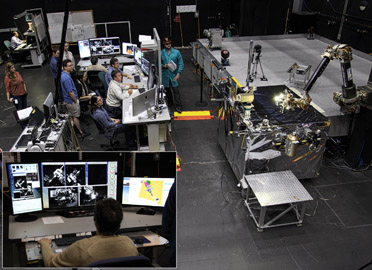NRL Engineers to Lead Payload Development for Robotic Servicing of Geosynchronous Satellites
With its newly announced Robotic Servicing of Geosynchronous Satellites (RSGS) program, the Defense Advanced Research Projects Agency (DARPA) plans to field an on-orbit satellite servicing vehicle that would transform U.S. space operations in Geosynchronous Earth Orbit (GEO). As the lead payload developer for the program, the Naval Center for Space Technology (NCST) at the U.S. Naval Research Laboratory (NRL) is committed and remains focused on integrating and validating the disparate components required to perform the RSGS mission.

U.S. Naval Research Laboratory (NRL) engineers in the Space Robotics Laboratory (SRL) demonstrate end-to-end robotic servicing rehearsals of the Front-end Robotics Enabling Near-term Demonstration (FREND) robotic arm using a remote ground station and operator to simulate on-orbit robotics.
“Our engineering team is extremely excited to be leading the government’s payload development for this innovative program,” said Bill Vincent, program manager for RSGS at NRL. “NRL has a long history of developing revolutionary spacecraft to meet emerging national needs. Just as NRL’s past developments led to the Global Positioning System, we look forward to having a similar role for on-orbit robotic servicing by helping develop the necessary high-risk payload technology and transitioning this technology to U.S. industry.”
RSGS — which would be able to robotically inspect, autonomously grapple, reposition, repair, and upgrade cooperative GEO spacecraft — would be a major step forward in the nation’s ability to manage and maintain GEO spacecraft. RSGS would increase the reliability and resilience of services provided by both commercial and government satellite operations by increasing asset stability and service life.
NRL research and development in robotic satellite servicing goes back nearly two decades, beginning with construction of the NRL Space Robotics Laboratory (SRL) in the late 1990s. The SRL is a world-class facility where the space environment can be simulated so that robotic satellite servicing techniques can be researched, developed, tested, and validated. It supports testing of full-scale hardware-in-the-loop rendezvous, docking, and servicing to include robotic arms, tools to support a variety of servicing missions, control schemes, relative navigation sensors, lights, and cameras, all of which must work as a system to accommodate the unique needs of client satellites in the harsh GEO environment.
Using the SRL facility and the core strength of the NCST in spacecraft systems engineering, NRL and DARPA began maturing the necessary technologies for on-orbit robotic servicing in 2002. One of the major developments in the 2000s was the Front-end Robotics Enabling Near-term Demonstration (FREND) robotic arm, built to NRL and DARPA specifications specifically for GEO servicing applications.
As the FREND robotics hardware was being developed, NRL engineers developed the equally important robotics control software necessary for safe and efficient on-orbit autonomous and ground-controlled robotic operations in space. “I often describe the control software as the invisible half of our program, just as important as the robotic arm,” said Bernie Kelm, deputy program manager for RSGS at NRL. “It takes the hardware, control algorithms, and flight software all working together to make this possible, and developing technologies needed to service satellites that were not originally designed for that purpose was closer to ‘science fiction’ when we started. We’ve now matured that capability to be realistic and ready for spaceflight.”
Today, as a result of this investment in robotics hardware, control algorithms, tools, mission concepts, payload electronics, sensors, and flight software, NRL has demonstrated end-to-end robotic servicing tasks using flight-traceable hardware and software. These lab demonstrations include a robotics operator control ground station, spacecraft payload control electronics, and prototype spaceflight robotic arms and tools that have undergone spaceflight qualification testing. The maturity of these component technologies will help ensure that DARPA’s RSGS would be able to service spacecraft reliably, efficiently, and effectively.
“NRL’s expertise in spacecraft systems engineering makes it uniquely qualified to perform this task,” Vincent said. “NRL and DARPA are well on the way to having this mission’s core technologies validated for spaceflight, and we look forward to working with a commercial partner to fully realize this capability on-orbit.”
Once deployed, RSGS would provide an unprecedented range of capabilities to meet current needs and provide a robust and flexible foundation for transforming space logistics and operations in GEO for the future.
Source: U.S. Department of Defense
- 314 reads
Human Rights
Ringing FOWPAL’s Peace Bell for the World:Nobel Peace Prize Laureates’ Visions and Actions

Protecting the World’s Cultural Diversity for a Sustainable Future

The Peace Bell Resonates at the 27th Eurasian Economic Summit

Declaration of World Day of the Power of Hope Endorsed by People in 158 Nations

Puppet Show I International Friendship Day 2020

